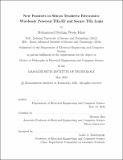New Frontiers in Silicon Terahertz Electronics: Wirelessly Powered THz-ID and Secure THz Links
Author(s)
Khan, Muhammad Ibrahim Wasiq
DownloadThesis PDF (14.12Mb)
Advisor
Han, Ruonan
Terms of use
Metadata
Show full item recordAbstract
Advances in silicon integrated electronics have enabled many significant systems and applications in the terahertz (THz) band over the last decade. However, ultra-low-power (<25𝜇W) or battery-less THz transceivers have not been explored yet due to the stringent challenges posed by them. Likewise, the notion of wireless power transfer at THz frequency is non-existence. There is a growing demand for low-power mm-size transceivers in supply chain management, assets tracking, authentication, micro-robotics, on-skin or close-to-skin implants, etc. With these ubiquitous THz-links, the security of the wireless channels is another emerging challenge. Advanced digital encryption techniques are computationally intensive, power-hungry, and not suited for these low-power applications. This thesis explores the challenges and novel approaches to realizing ultra-low-power/battery-less and physically secure THz transceivers. Specifically, it demonstrates three new frontiers in standard CMOS technologies that will open up the THz band. The first is a mm-size 0.26 THz identification tag (THz-ID) enabling 𝜇W level THz link by exploiting back-scattering and beam-steering functionalities. It is the smallest, package-less, monolithic ID chip with far-field communication capability and asymmetric cryptography. The second is the optimization based on dual-antenna architecture for 0.26 THz energy harvesting with ∼25𝜇W harvesting capability. It is the highest frequency of CMOS harvester by ∼3x and has the highest RF-to-DC conversion efficiency at low input power. And the third is developing an orbital-angular-momentum (OAM) wave-based transceiver with bits-to-OAM modes mapping for secret key distribution at 0.31 THz frequency. It is the first chip-based demonstration (at any frequency) of a transceiver front-end that transmits and receives OAM waves. It is also the smallest, least power consuming OAM transceiver and it can dynamically switch among OAM modes. The thesis concludes with potential improvements and prospects for future work.
Date issued
2022-05Department
Massachusetts Institute of Technology. Department of Electrical Engineering and Computer SciencePublisher
Massachusetts Institute of Technology